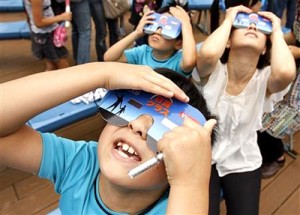 When it comes to looking at the sun, eclipsed or not, it can be dangerous to look at it directly. NEVER look at the sun directly, even with sunglasses. You can potentially damage your eyes, which could lead to temporary or permanent blindness. However there are plenty of ways to look at the sun at any given time, or during an eclipse event, such as the annular eclipse coming up on May 20, 2012. Here are a few and cost effective (and even fun) aways you can view the eclipse:
When it comes to looking at the sun, eclipsed or not, it can be dangerous to look at it directly. NEVER look at the sun directly, even with sunglasses. You can potentially damage your eyes, which could lead to temporary or permanent blindness. However there are plenty of ways to look at the sun at any given time, or during an eclipse event, such as the annular eclipse coming up on May 20, 2012. Here are a few and cost effective (and even fun) aways you can view the eclipse:
Purchase Filters Telescope Solar/H-alpha filters: If you own a small telescope, it is likely there is a solar/H-alpha filter that can be fitted for your scope. It is a nice way to view the eclipse. And if you are into astro-photography you could even take a few snapshots or videos of the eclipse (see example here). Solar filters for scopes can really range in price, so this method would probably be the most costly. Binoculars: If using binoculars, make sure to use a proper solar filter just as you would for a telescope. Many online stores will carry such filters as well. Or wear your solar/eclipse glasses and then use the binoculars over them. Do It Yourself Pinhole Projectors: There are many ways to project the sun’s image via a pinhole, but the basic idea is to take 2 white pieces of stiff paper/cardboard. Using a pin, puncture a whole in one of the papers. Place the pinhole paper in the path of the sun and hold the other paper behind it to project the sun onto it. Adjust the distance between the papers until projected image is to a satisfactory size/focus. What you see on the projected paper is the actual image of the sun and not just a dot of light coming through it! Variations of pinhole projectors: one can get very creative with pinhole projectors. Here are a few resources to give you some ideas: SAFETY Solar/Eclipse Glasses: you can purchase these little glasses from many online store (Amazon.com and OPT Corp just to name a few). Prices range from $3 to $15.
Solar/Eclipse Glasses: you can purchase these little glasses from many online store (Amazon.com and OPT Corp just to name a few). Prices range from $3 to $15.
